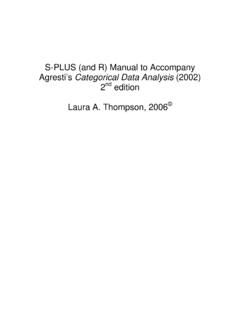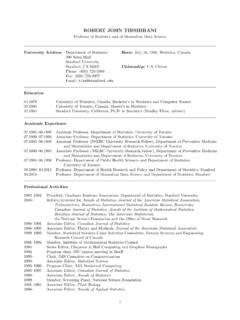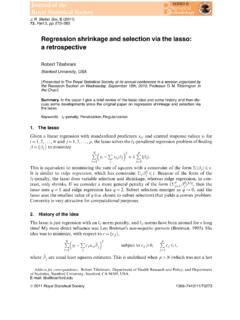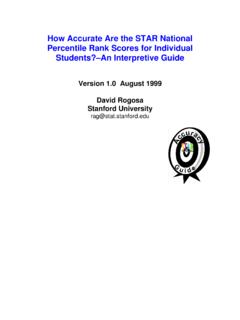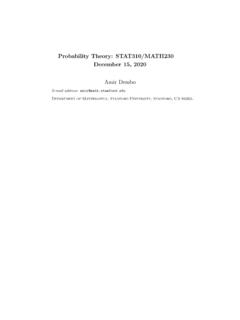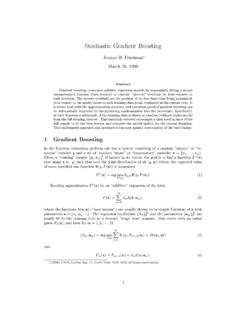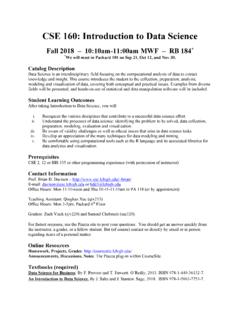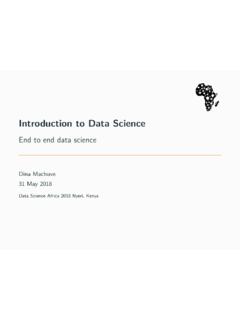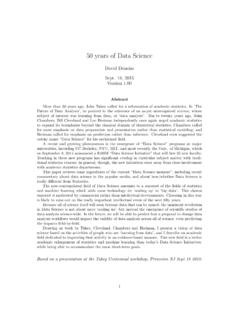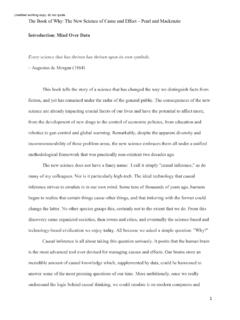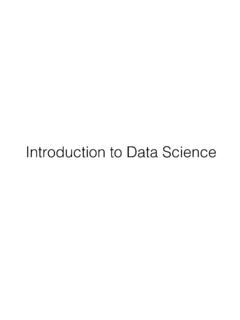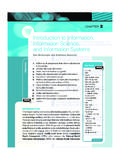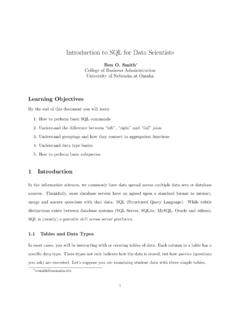Transcription of Data Science, Statistical Modeling, and Financial and ...
1 data Science, Statistical Modeling, and Financial and Health Care ReformsTze Leung LaiDepartment of Statistics, Stanford UniversityStanford, CA 94305-4065, USAA bstractThis paper discusses some new trends in the field of Statistics, in response to technologicalinnovations leading to big data as well as opportunities and challenges in the wake of healthcare and Financial reform IntroductionThe past decade witnessed exciting developments and new trends in Statistical modeling and itsapplications. These trends are related to the explosion of digital data , as pointed out in thearticle For Today s Graduate, Just One Word: Statistics ofThe New York Times(August 6,2009): In field after field, computing and the Web are creating new realms of data to explore sensor signals, surveillance tapes, social network chatter, public records and more. Andthe digital data surge only promises to accelerate, rising five-fold by 2012, according to aprojection by IDC, a research firm.
2 Even the recently ended Netflix contest, which offered $1 million to anyone who couldsignificantly improve the company s movie recommendation system, was a battle waged withthe weapons of modern statistics. , seeing an opportunity in data -hunting services, created a Business Analytics andOptimization Services group in April. The unit will tap the expertise of the more than 200mathematicians, statisticians and other data analysts in its research labs but the numberis not enough. If the data explosion magnifies longstanding issues in statistics, it also opens up new fron-tiers. Closely related to these developments is big data , which is one of the most promising businesstrends in the past decade and which has also led to the development of a new interdisciplinaryprogram called data science. In Section 2 we give an overview of data science and also describesome active areas of research on Statistical modeling and analysis of big past few years also witnessed the beginning of a new era in Financial markets and in the UShealth care system.
3 In March 2010, landmark health care reform was passed through two federalstatutes: the Patient Protection and Affordable Care Act and subsequently amended by the HealthCare and Education Reconciliation Act. A few months later, the Dodd-Frank Wall Street Reform1and Consumer Protection Act was signed into law in the US on July 21, 2010, in response towidespread calls for regulatory reform following the 2007-2008 Financial crisis. In Section 3 andSection 4 we discuss the challenges and opportunities for innovative study design, data analysis,and Statistical modeling in this new era for finance and health data science and Statistical methods for big dataThe term data science arose in the field of computer science. In 1974, Naur [55] freely used thisterm in his survey of contemporary data processing methods for a wide range of applications. In thefield of statistics, Cleveland [17] introduced this term as a new direction for the field in 2001.
4 Twoyears later, theJournal of data Sciencebegan its publication under the founding editor Min-TeChao of the Institute of Statistical Science at Academia Sinica. It currently has editorial offices inTaipei (Fu Jen University), Beijing (Renmin University), and New York (Columbia University). Itsemphasis is on Statistical methods at large for collecting, analyzing, modeling data in scope is very different from that of theData Science Journal, which started in 2002, and which publishes data or data compilations if the quality of data is excellent or if significant efforts arerequired in compilation. data science, therefore, includes high performance computing, data processing, developmentand management of databases, data warehousing, mathematical representations, Statistical model-ing and analysis, and visualization with the goal of extracting information from the data collectedfor domain-specific applications.
5 Interdisciplinary graduate programs to train data scientists arebeing established at a number of universities, including Columbia, Stanford, New York University,and North Carolina State University. At Stanford, the MS programs in Statistics and in Computa-tional & Mathematical Engineering will offer a joint data Science track, beginning in the 2013-14academic year. The track offers courses in advanced Statistical methods and models, machinelearning and data mining, high-performance computing, numerical analysis and optimization, andapplied and computational mathematics. In addition, PhD programs in the Departments of Statis-tics and Computer Science, and in the Institute of Computational & Mathematical Engineeringcover different aspects of research in data of the most active areas of data science research is related to very large data sets, or bigdata, which pose computational and Statistical challenges.
6 As an illustration of the statisticalchallenges, consider the linear regression modelyt= + 1xt1+ + pxtp+ t,(t= 1,..,n),(1)in which trepresent random, unobserved disturbances withE( t) = 0. Estimation of the regressionparameters , 1,.., pis an age-old topic now often taught in introductory statistics became a hot topic again in the last decade, in response to data explosion that results inp(# of input variables) considerably larger thann(sample size). Thep nproblem appearshopeless at first sight since it involves many more parameters than the sample size and therefore theparameters cannot be well estimated, resulting in unacceptably large variances of the estimates. Onthe other hand, it was recognized that the regression functionf(x1,..,xp) = + 1x1+ + pxpis still estimable if the regression model is sparse and that many applications indeed involvesparse regression models.
7 Such problems are of increasing importance in genomics, in whichnis the number of subjects in a clinical study that requires informed consent of human subjectsandpis the number of locations in a genome at which measurements are taken. Advances in high-throughput microarray technology have resulted in data explosion concerningp, but it is difficult torecruit patients into clinical trials, resulting inn p. There are two major issues with estimating2 = ( 1,.., p) whenp n. The first is singularity ofX X, whereX= (xtj)1 t n,1 j the row vectors ofXbyXt, note that thenvaluesX1 ,..,Xn cannot determine thep-dimensional vector uniquely forp > n. Assuming the tto be independent and identicallydistributed ( ) normal and using a normal prior N(0, I) can remove such singularity sincethe posterior mean of is the ridge regression estimator [29, Sect. ]: ridge= (X X+ I) 1X Y,(2)whereY= (y1.)
8 ,yn) . The posterior mean minimizes the penalized residual sum of squares Y X 2+ 2, with theL2-penalty 2= pj=1 2jand regularization parameter .The second issue with estimating whenp nis sparsity. Although the number of parametersis much larger than the sample size, one expects for the problem at hand that most of them are smalland can be shrunk to 0. While theL2-penalty does not lead to a sparse estimator ridge, theL1-penalty pj=1| j|does. The minimizer lassoof Y X 2+ pj=1| j|introduced by Tibshirani[68], is called lasso (least absolute shrinkage and selection operator) because it sets some coefficientsto 0 and shrinks the others toward 0, thus performing both subset section and shrinkage. Unlikeridge regression, lassodoes not have an explicit solution unlessXhas orthogonal columns, but canbe computed by convex optimization algorithms. Oracle inequalities for nt=1( yM(xt) y(xt))2have been developed recently, whenMis lasso or the closely related Dantzig selector, by Cand esand Tao [13], Bickel et al.
9 [10], and Cand es and Plan [14]. Zhao and Yu [73] and Zhang and Huang[72] have also shown that lasso is variable-selection consistent under certain and Hastie [75] introduced the elastic net estimator enetthat minimizes a linear combina-tion ofL1- andL2-penalties: enet= (1 + 2) arg min { Y X 2+ 1 1+ 2 2},(3)where 1= pj=1| j|. The factor (1 + 2) in (3) is used to correct the double shrinkage effectof the naive elastic net estimator, which is Bayes with respect to the prior density proportionalto exp{ 2 2 1 1}, a compromise between the Gaussian prior (for ridge regression) andthe double exponential prior (for lasso). Note that (3) is still a convex optimization problem. Thechoice of the regularization parameters 1and 2in (3), and in ridge regression or lasso, is carriedout byk-fold cross-validation [29, Sect. ].Since the non-convex optimization problem of minimizing Y X 2+ p j=1I{ j6=0},(4)which corresponds to theL0-penalty, is infeasible for largep, lasso is sometimes regarded as anapproximation of (4) by a convex optimization problem.
10 Ing and Lai [30] recently introduceda fast stepwise regression method, called theorthogonal greedy algorithm(OGA), following theterminology introducted by Temlyakov [66], and used it in conjunction with ahigh-dimensionalinformation criterion(HDIC) for variable selection along the OGA path. The method, whichprovides an approximate solution of theL0-regularization problem, has three components. Thefirst is the forward selection of input variables in a greedy manner so that the selected variablesat each step minimize the residual sum of squares after ordinary least squares (OLS) is performedon it together with previously selected variables. This is carried out by OGA that orthogonalizesthe included input variables sequentially so that OLS can be computed by component-wise linearregression, thereby circumventing matrix inversion. The second component of the procedures is3a stopping rule to terminate forward inclusion afterKnvariables are included.
